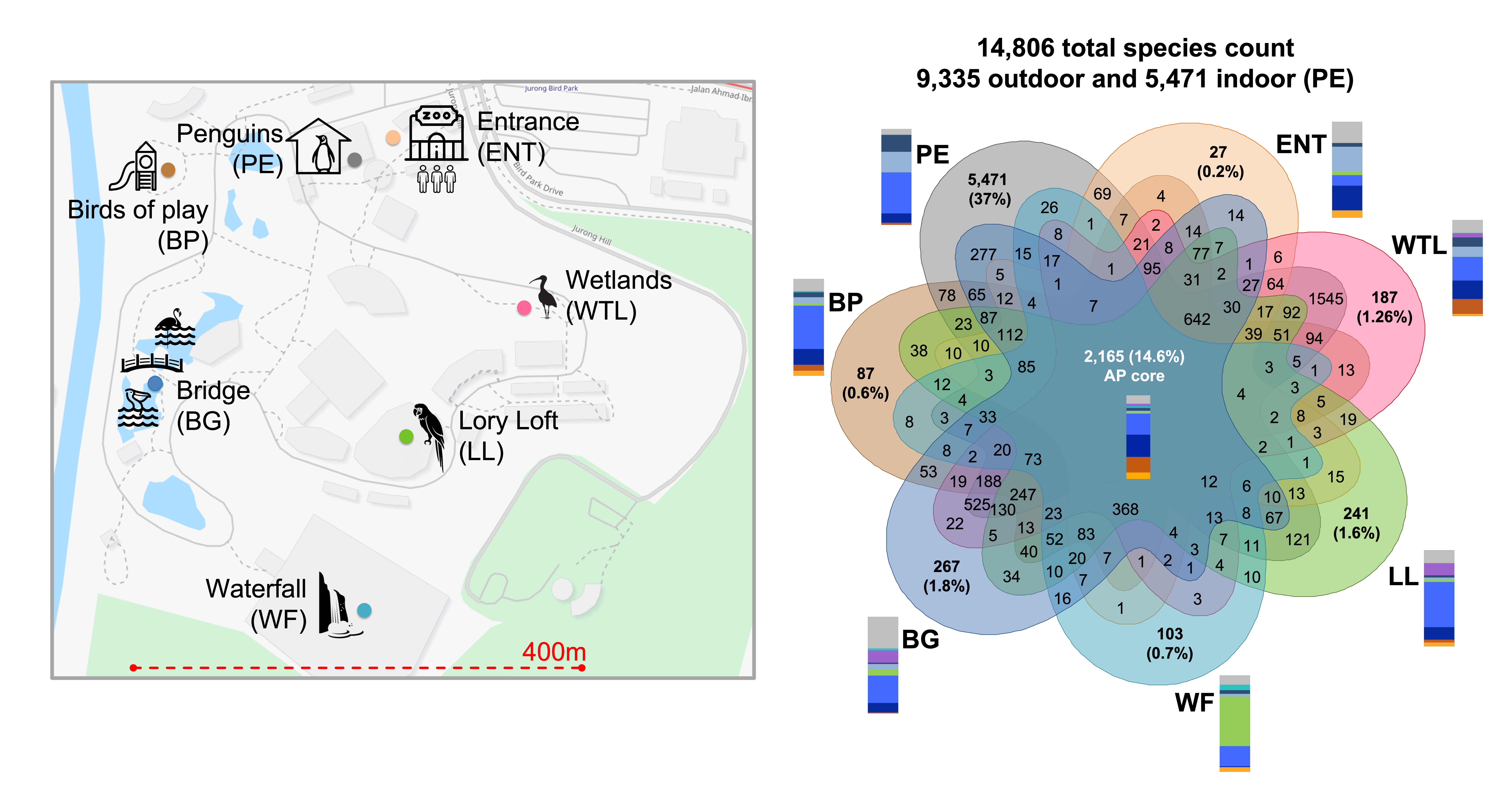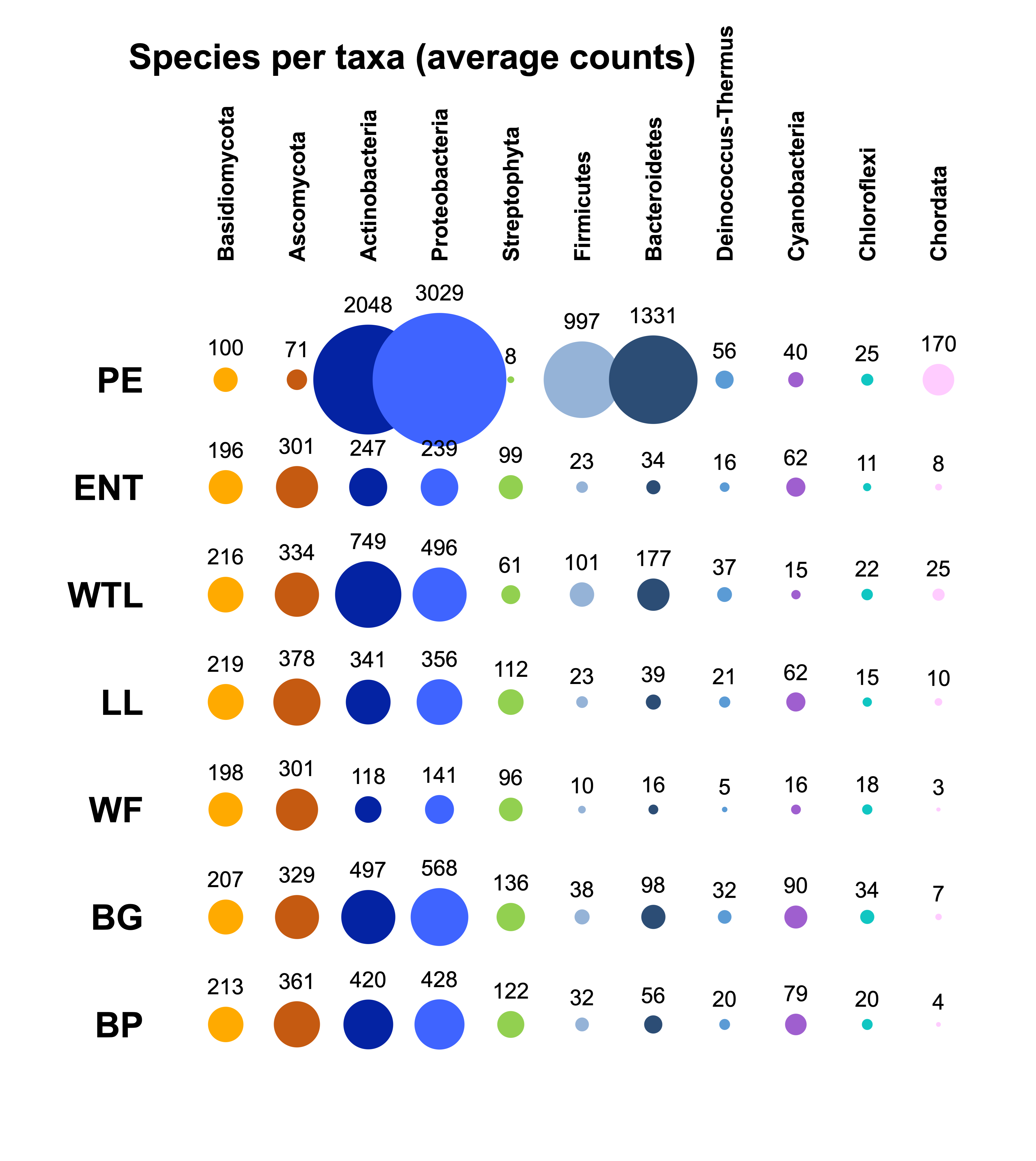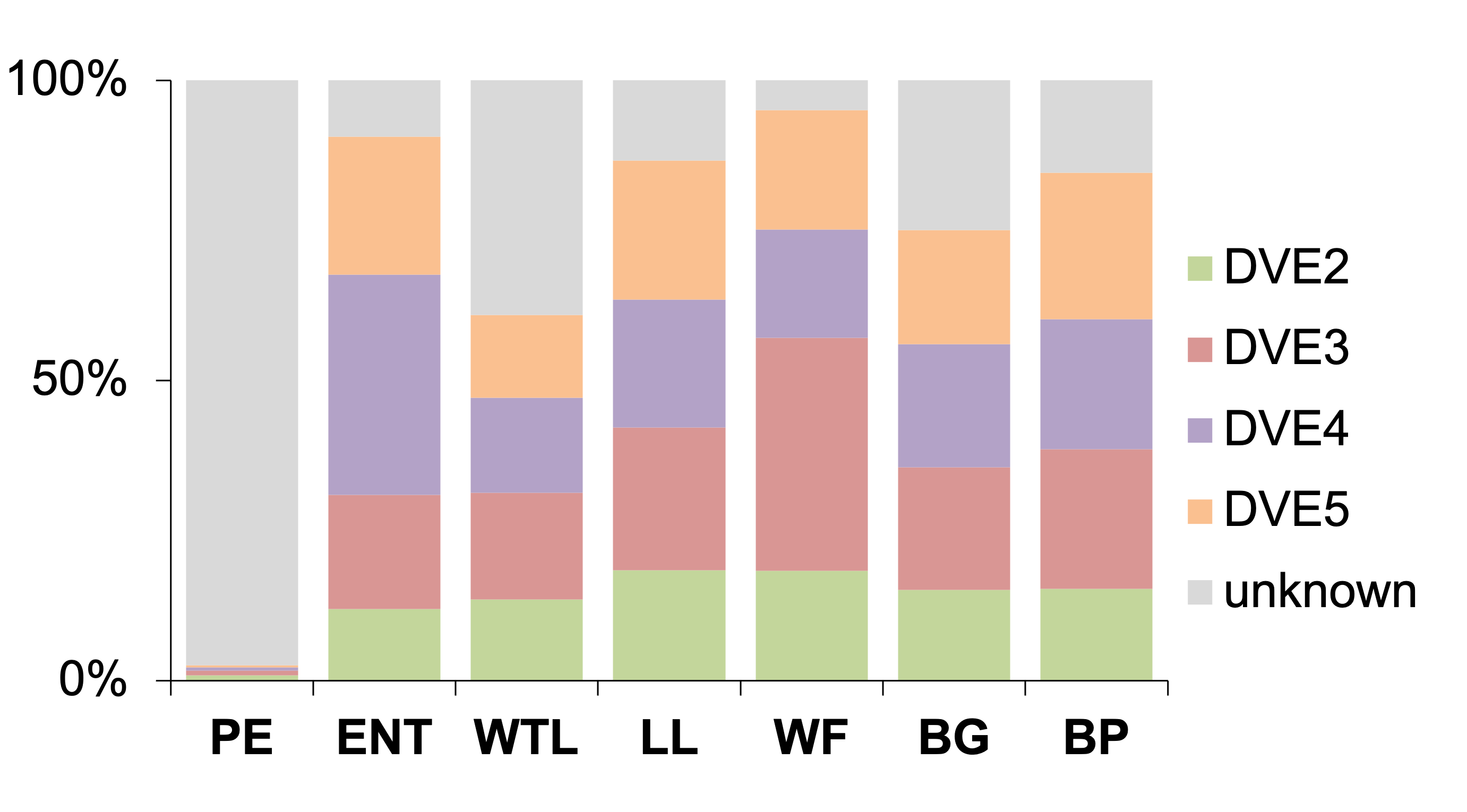Local Sources
Short-range contributions of local sources to ambient air
 (LEFT) Experimental design and sampling at different microhabitat locations in the 160,000 m2 tropical avian park (AP). OpenStreetMap (www.openstreetmap.org) was used for the map representation
(LEFT) Experimental design and sampling at different microhabitat locations in the 160,000 m2 tropical avian park (AP). OpenStreetMap (www.openstreetmap.org) was used for the map representation (RIGHT) Venn-diagram of species co-occurring in seven microhabitats of the AP. The core species identifiable across all the microhabitats are indicated in white. Bars indicate the relative composition (in counts of species) of the corresponding location-specific microbial communities
Microhabitats contain characteristic air microbiome
 ( Richness of the top 11 most abundant phyla across the microhabitats. Species counts are indicated )
Using novel sampling and analysis strategies, SCELSE’s air microbiome team has studied the microbial communities of the air, and described the constituents of these communities, as well as their spatial and temporal variation. Thus far, we have demonstrated the variability in community structure, driven by factors such as time of day, temperature, humidity, and precipitation as well as the explored the vertical boundaries and organization of the air microbiome. Here we were able to expand our investigation of the breadth and boundaries of dynamic microbial communities as we assessed the contributions of local sources to ambient air within a 160,000 m2 tropical avian park located in Singapore.
( Richness of the top 11 most abundant phyla across the microhabitats. Species counts are indicated )
Using novel sampling and analysis strategies, SCELSE’s air microbiome team has studied the microbial communities of the air, and described the constituents of these communities, as well as their spatial and temporal variation. Thus far, we have demonstrated the variability in community structure, driven by factors such as time of day, temperature, humidity, and precipitation as well as the explored the vertical boundaries and organization of the air microbiome. Here we were able to expand our investigation of the breadth and boundaries of dynamic microbial communities as we assessed the contributions of local sources to ambient air within a 160,000 m2 tropical avian park located in Singapore.
Air samples were taken from seven locations situated 160-400 m apart across the park, with each site representing distinct microhabitats, marked by either characteristic land types, such as lakes or waterfalls, or had a high density of specific bird species. The samples from each location showed characteristic air microbiomes, defined by the abundance and richness of its airborne microbial community members. We saw observed that outdoor microhabitats contained up to 18.6% location-specific taxa, while 1/3 of the air microbiome was shared between sites. The remaining microbial taxa were identified as the ambient air background of urban tropical Singapore by comparison to a reference dataset from a location 2 km away. This data was collected during a year-round sampling campaign part of the diel cycle studies. Only 3.9% of species were specific to the urban site located on a building within the NTU campus.
 ( Microbial source tracking at the AP microhabitat locations. In the source tracking modelling, the DVE2-5 microbial communities were considered as sources while AP microhabitats were considered as sinks )
This study integrates the observations from the diel cycle and vertical stratification projects,
as it reiterates the day time dependence of the air microbiome, as well as the fact that air masses below the boundary layer height are highly admixed and therefore form the ambient air background of a metropolitan area.
The study further demonstrated the pronounced differences between indoor and outdoor locations as shown in comparison with the indoor microhabitat of the penguin enclosure. For this setting, no fungal airborne microorganisms were found, which strongly contrasts the vegetation of the outdoor settings.
As a result, we observed that sites with animal and human host microbiomes are likely dominated by bacterial bioaerosols, while an abundance of fungal taxa is observed for tropical settings where wood-rotting fungi belonging to the Basidiomycota phylum are most frequent.
The qualitative and quantitative assessment of local sources of airborne biomass against the ambient air background therefore allows for the identification of local source contributions even in naturally ventilated outdoor settings.
Our analyses therefore suggest that even within a small-scale area one can accurately identify contributions from local sources to the ambient air background, despite the prevailing mixing of air masses caused by atmospheric turbulence.
( Microbial source tracking at the AP microhabitat locations. In the source tracking modelling, the DVE2-5 microbial communities were considered as sources while AP microhabitats were considered as sinks )
This study integrates the observations from the diel cycle and vertical stratification projects,
as it reiterates the day time dependence of the air microbiome, as well as the fact that air masses below the boundary layer height are highly admixed and therefore form the ambient air background of a metropolitan area.
The study further demonstrated the pronounced differences between indoor and outdoor locations as shown in comparison with the indoor microhabitat of the penguin enclosure. For this setting, no fungal airborne microorganisms were found, which strongly contrasts the vegetation of the outdoor settings.
As a result, we observed that sites with animal and human host microbiomes are likely dominated by bacterial bioaerosols, while an abundance of fungal taxa is observed for tropical settings where wood-rotting fungi belonging to the Basidiomycota phylum are most frequent.
The qualitative and quantitative assessment of local sources of airborne biomass against the ambient air background therefore allows for the identification of local source contributions even in naturally ventilated outdoor settings.
Our analyses therefore suggest that even within a small-scale area one can accurately identify contributions from local sources to the ambient air background, despite the prevailing mixing of air masses caused by atmospheric turbulence.
In partnership with:

Special thanks to Jessica GH Lee, Safiah Basir, Hafiz Yani, and Prabu Philip for their warm welcome and help at the Jurong Bird Park, Singapore